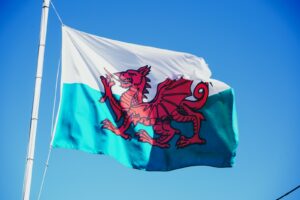The Little Laverbread Book aims to spread the love of Wales’ most iconic ingredient
The book has been penned by Jonathan Williams, founder of National Laverbread Day
A ground-breaking new book gives a platform to an iconic Welsh food: laverbread. The Little Laverbread Book was written by laverbread aficionado Jonathan Williams, who has built several businesses around Welsh seaweed.
Laverbread is made by boiling laver (porphyra seaweed) for hours until it becomes a dark green paste. It’s traditionally eaten with cockles as part of a Welsh breakfast, but as Jonathan’s book demonstrates, there are many other ways to enjoy it.
Growing up in Pembrokeshire, Jonathan first learnt about laverbread through the landmark seaweed drying hut at Freshwater West beach. He used to go cockling nearby with his grandmother, but it wasn’t until he moved to Swansea as a student that he really got to grips with laverbread as food.
“I remember being a bit scared of the laverbread ladies on Swansea Market – they were a feisty bunch,” he says. “That’s when I started cooking laverbread for my uni mates and flatmates.”
Fast forward about a decade and Jonathan had left a desk job in Swindon to relocate back to Pembrokeshire, where he set up a street food outlet, Café Môr, at Freshwater West beach. Café Mor is famous for its distinctive appearance (it’s a converted fishing boat) and its unique menu which uses laverbread in everything from burgers to breakfast baps and lobster rolls.
Jonathan also took Café Môr on tour to festivals across the UK, where it won plenty of awards. Soon, interest in his seaweed creations was so high that he decided to launch The Pembrokeshire Beach Food Company, which makes everything from seaweed salt and ketchup to seaweed biscuits and butter. He also launched another company, Barti Rum, which produces an award-winning seaweed spiced rum.
By 2022 Jonathan was looking for a new challenge, so he took on The Old Point House on Angle in deepest Pembrokeshire. A former pirates’ haunt, this atmospheric pub, which is reached via a tidal causeway, is the new home for Café Môr and also has an indoor menu built on seaweed sourced from the pub’s own secret sea garden.
Explaining his long-lasting fascination with laverbread, Jonathan says:
“It’s an extraordinary ingredient. Nothing looks so disgusting after seven hours of cooking – to put in a lot of work to produce something that looks like that is an achievement in itself! It’s collected off the Atlantic Coast in one of the second-biggest tidal ranges in the world. People are only just starting to realise how packed it is with protein, vitamins and minerals: I’ve been it sending off to labs and its protein levels are 30% plus, which is extraordinary.
“Laverbread’s life cycles are fascinating too, and have only really been understood recently. It can be male or female, both, or neither, all at the same time. It lives on the wild fringes of the British Isles, on really exposed beaches that get absolutely battered by the storms, and it’s an important coloniser, paving the way for other species.”
While the Welsh selected laver from over 1000 species of seaweed on its coastline and decided to boil it to make into its national delicacy, other countries made different choices.
“The Welsh decided to boil lava up to make this sticky, gooey thing,” says Jonathan. “The Japanese make laver into paper-thin sheets, and in America, they used to ferment it. The Irish and Scottish went for dulse seaweed instead.”
Besides its fascinating history and the fact that he adores cooking with it, Jonathan’s commitment to laverbread is based on its promise as a planet-saving future food.
“It has the potential to be a hugely important sustainable food source because it doesn’t require any land, fresh water or pesticides. It has a really high growth rate of about 1 or 2 centimetres a day in peak season, and holds more vitamins and minerals than any land-based vegetable. Having it as part of your diet could help future generations. It could be used in mass products, and incorporated into everyday dishes such as baked beans or Bolognese to enrich them with extra vitamins and minerals.”
Jonathan’s mission to promote laverbread consumption led him to launch National Laverbread Day, which takes place every year on April 14. And now he’s published his book to help people get to know laverbread better.
The Little Laverbread Book includes 20 laverbread recipes that demonstrate the versatility of this remarkable ingredient, with options ranging from laverbread Welsh rarebit to laverbread lobster rolls. Interestingly, after years enjoying laverbread, Jonathan’s favourite way to eat it is incredibly simple:
“I’m a purist now and my favourite thing is hot laver, spread on a slice of hot buttered toast,” he says. “It also works beautifully in a fish pie, and I love the pasta dish in the book which includes crab, lobster, laverbread, anchovies, chilli, Parmesan and garlic.”
Besides recipes, the book includes sections on the history, cultural significance and science behind laverbread.
“The reason I wrote it in the first place is that this is an incredible ingredient and we should be proud of it,” says Jonathan. “We should be singing about from the mountain tops: it’s uniquely Welsh, it’s hugely versatile, and it’s got fantastic potential as part of our future diets. I would like to see laverbread celebrated like the truffles are celebrated in France – so this book is a big celebration of what laverbread can do.”




